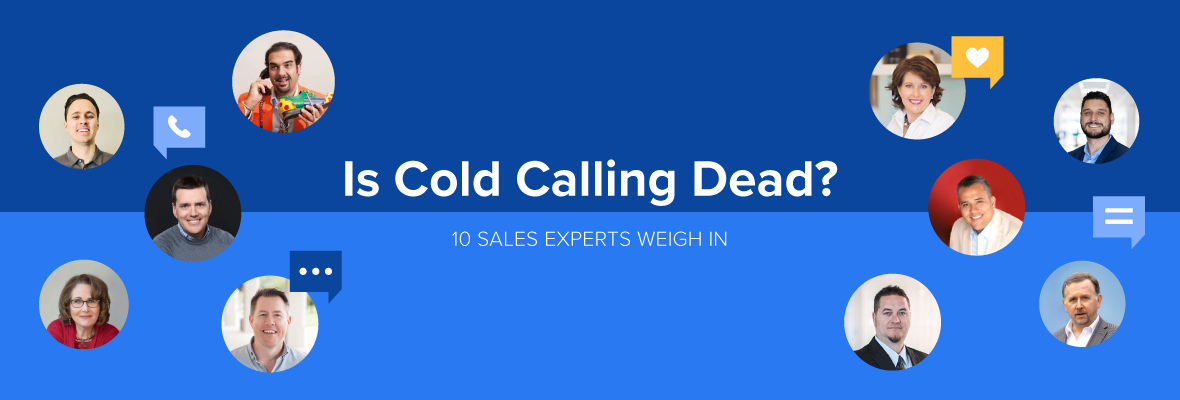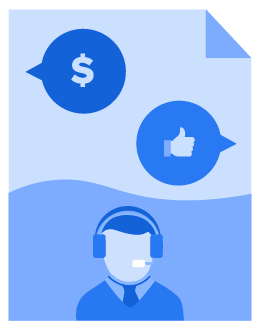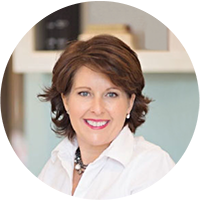Is Cold Calling Dead? 10 Sales Experts Weigh In

EBQ
Is cold calling dead? According to the experts, cold calling is still very much alive. The strategies have just changed — because today’s buyers have changed how they buy. Business buyers have very little patience for truly cold calls. Now, sellers must view cold calls as a single touchpoint, part of a more holistic approach to engaging with buyers.
We invited 10 sales and sales development thought leaders to share their insight about the state of cold calling. In this post, we set out to answer the following questions:
- Is cold calling dead?
- What mistakes are companies making when it comes to cold calling?
- How can cold calling efforts be aligned with how buyers today prefer to buy?
- How can a company know that cold calling is suitable for their business or product?
- Is the cold calling strategy of targeting top-level execs still relevant for 2020?
- How have you been able to make cold calling work in your business? Any significant breakthroughs?
↓ Keep reading to see what the experts have to say.

Download the Best Cold Call Scripts for Software Sales
Our guide includes sales expert’s insights and best practices. Free for anyone who’s ready to create high-converting scripts.

Lisa McLeod
The biggest mistake companies are making when cold calling is making a truly cold call. With absolutely no information about the prospect. Cold calling first began in the 1800s. Long before the invention of the internet.
Today, there’s no reason to call someone if you truly know nothing about them. Even two minutes on the internet can give you some insights into the compelling challenges of a particular industry and the history of the company you’re calling on.
That little bit of data allows you to make a more authentic connection earlier, and build a relationship, versus “cold” pitching that is generic. If your Noble Purpose is to add value to customers, you need to understand them before pitching your solution.

David Dulany
Founder & CEO of Tenbound ,
a research & advisory firm 100% focused on Sales Development.
DavidDulany.com
How can cold calling efforts be aligned with how buyers today prefer to buy?
It goes without saying that buyers today have a very different set of tools at their disposal versus just 10 or 20 years ago. There’s a tremendous amount of information online and on social networks that they can use in order to make a purchase decision.
Think of the last time that you purchased a product. You probably started with a Google search where you didn’t leave the first page of results, and you started to get a feeling for what was out there. You may have checked a few review sites to see what other people are saying and see who the top players are in the market.
Once you narrow down your top three or four, you probably went to their websites and started to look at their content and thought leadership. Are they legit?
At some point in this process, your phone probably rang with an unknown number that you either blocked or sent to voicemail. If you decided to take that call or listen to your voicemail, and it was someone describing a problem that you were trying to solve at the moment and how they may have helped, you might have added that company to your list of ones that you were checking out and you may have then filled out their lead form or taken a demo.
Here’s the important point: had no one ever made that call, you may have never heard of the company and never added them to your shortlist. That right there is the value of cold calling in 2020. In the competitive market we live in, you want to use every measure possible to get into the conversation and ensure that buyers know that you are one of the players in the space and one of the top players and/or solving the specific issues that they’re having.
So it starts with really knowing your industry now, knowing the vocabulary and becoming a student of the problems that your potential buyers have. That way when you make the call, you can be talking about how you can help them to solve problems and introduce one of the options which is your solution.
You must be highly skilled and trained for if they do answer the phone or listen to the voicemail because you want to be able to state their pain points, state your value proposition, handle objections and close for the meeting if you happen to catch them at the right time.
But you’re never going to know that if you don’t make the call!

Michael Edwards
Is cold calling dead?
Cold calling is not dead. In fact, it still remains one of the top (if not the top) ways to successfully “connect” to your audience. If you want Bank of America as a customer, you can’t just sit back and wait for them to call you. Talk about a long sales cycle. 😊If your business requires any flavor of educating your audience — whether the education is a new category, product updates/enhancements, new features or pains addressed — cold calling is essential. “If you build it, they will come” just doesn’t exist.
To give yourself the best chance, you have to do everything possible to gain market share. Continuous enhancement of database, SEO, trade shows, email automation, social media ads, and most importantly outbound calls to potential customers.
You can do everything possible to warm your database up, but in the end you have to have someone pick up the phone and call the people that aren’t calling you.

What mistakes are companies making when it comes to cold calling?
If you want to resonate with your buyers — and not fall on deaf ears — you must get super clear on who you help and how you help. If you don’t clearly communicate the business problem that you actually solve, you’re never going to be able to build value! And no fancy approaches are going to help you connect with buyers eager to run the other way, either! This is one area that sales leaders fail to inspect. That is, what is the seller saying to “capture” the buyer’s attention in less than 30 seconds and speaks to the business problem YOU solve. There’s a constant debate in the sales world today when it comes to the right way to cold call or if you should even do it. Many sales leaders are only focused on what worked for them and thus implement decisions that worked 15 years ago but certainly don’t work in total today. This usually includes forcing “prospecting days” where they are measuring how many cold calls each rep made. That is just plain old school and does not work. There are a lot of options out there – email, phone, social media, video calls, text messages, advertising, etc. The end game is not measuring how many cold calls, measure how many conversations did a rep have today or the number of meetings booked regardless of the medium. Sales leaders have also failed to integrate digital sales with traditional sales methodologies such as:- Leveraging the phone to call someone with insights
- Using email in a way that creates a human to human connection
- Developing a sales prospecting cadence program that includes outreach via social video, texting, email, phone, social networks, etc.

Deb Calvert
President, People First Productivity Solutions
Is cold calling dead?
Cold calling is not dead. But it might kill selling unless we abandon the ineffective, offensive, brand-damaging practices collectively known as cold calling. They don’t work, they’re not ever going to work, and we can do better.How can a company know if cold calling is suitable for their business or product?
Cold calling might be suitable for any business or product. But it’s not suitable for any business if it’s done wrong. In fact, cold calling practices can impair business performance and injure your brand. Spammy emails, annoying LinkedIn solicitations, and ambush drop-ins are not welcomed by buyers. The amount of time/effort that goes into these activities is simply not a good investment for the payoff (especially when you factor in the negative perception about your brand that cold calling creates). A better question to ask is “Is outbound selling suitable for this business or product?” The answer to that question is “yes” unless your inbound marketing is so strong that you don’t need additional sales. Outbound selling can be much more sophisticated than hackneyed cold calling tactics. Referral selling, gathering prospect intel, using AI to profile buyers, and other strategies make outbound selling more effective. These require training and coaching. Without support, it’s back to square one with sellers making cold calls that hurt more than they help.Is the cold calling strategy of targeting top-level execs still relevant for 2020?
Targeting top-level executives is an acceptable option if your product is used by executives and/or requires top-level budget approval. Targeting the C-suite is not a good practice if your product is a line item in an existing budget. In that case, the decision about which vendor to use is usually up to the department head (not division head). There’s one other consideration. Does your product align with the strategic vision of the company? If you sell copiers, for example, there is not a clear and compelling link to a vision or strategic plan. Copiers are related to day-to-day tasks. Therefore, this purchasing decision is unlikely to be made in the executive suite (unless it’s a small organization). More typically, executives focus on bigger picture and higher impact decisions. They delegate decision authority to others who operate the business. In 2020, this is more true than ever. Despite the strong economy, 2019 saw more CEO departures than any other year on record. There’s a lot of movement in and pressure on the C-suite. That’s what executives will be focused on, along with the big picture. While going straight to the top seems, at the surface, like an efficient approach, it’s not. It precludes sellers from developing internal advocacy and gathering intel from the end users and people most impacted by the purchase of a new product. Starting where the need is felt most keenly is usually a better choice.
Will Cannon
Founder & CEO, UpLead
How can cold calling efforts be aligned with how buyers today prefer to buy?
Obviously, you need to talk about your product or service on the phone. But here’s the thing: buyers will form their own opinion anyway. If you’re using the call for plain product presentation, the prospect will probably have the feeling that this conversation is only meant to win him as a new customer as quickly as possible. Hence, chances are good that he or she will be unlikely to buy. Instead, you should make your buyer’s life easier and provide immediate value.
Motivate your discussion partner to ask questions he or she would have googled otherwise. For example, you can talk about how your product (realistically) compares to your competitors or valuable best practices that immediately help your prospect (even without buying your product). This way, you’ll be able to provide the answers to your lead’s questions and to give your prospect the feeling that it’s not only about convincing him to buy.
How have you been able to make cold calling work in your business? Any significant breakthroughs?
We’re using a mixed approach including cold emails and “warmed up” cold calls. There are so many great email prospecting tools out there and you can use them to trigger cold calls based on your prospect’s behavior. Email tracking allows you to derive learnings about your prospect’s interest.
For example, before your call, you can send out a cold email campaign, providing value upfront (for example, by sharing an interesting blog post) and figure out whether the prospect opened and engaged with your message. This way, we make sure that we only contact prospects who have a decent level of motivation to receive a call from us.

Bob Apollo
Founder, Inflexion-Point Consulting
Is cold calling dead?
Unprepared, poorly researched calling should have died out a long time ago. When reaching out to a potential prospect who has had no previous awareness of or interaction with you or your organisation, your first goal must be to find out if they have a real or potential business issue that you can address. You should already have a hypothesis about their potential needs and the threats or opportunities they are likely to be facing. And whilst social media — and in particular LinkedIn — can be a valuable prospecting tool, you have to use it with some finesse. Following up an accepted connection request with an immediate meeting request or an inept product pitch (both things I have suffered many times) is hardly likely to be the foundation for a successful relationship. Share something valuable before you ask for something valuable in return. Your objective is to uncover the problem, not sell your company or your so-called solution. You need to share what you have learned from similar people in similar roles. And at the end of the call, your prospect needs to believe that they have learned something useful, that their time was well spent and that continuing the conversation will be to their advantage. If you do that, you will be naturally aligned with how buyers prefer to buy today.
Jake Dunlap
Founder & CEO, Skaled Consulting
How can a company know if cold calling is suitable for their business or product?
I’m a big fan of not reinventing the wheel. What I mean in terms of knowing if cold calling is suitable for your business or product, is if industry peers are already successfully cold calling, then you should probably be doing it as well — and it’s pretty easy to test. Simply, contact your peers and ask them if they’re currently cold calling or hit up their SDRs. You’ll get your answer in about a week. Another thing to think about is are you targeting people that most likely have desk phones. Are you calling roles like Finance, Legal, or HR where people are consistently at their desk, the phone is right there ringing, and they can either choose to answer or not. These types of roles have a higher probability of answering. If you’re targeting people out in the field, do you have a database that provides their mobile numbers? Calling someone’s mobile is becoming more and more acceptable. The FCC has also passed new legislation on robocalls this past year, so the phone is really going to start to open up away from spam as robocalls become illegal.Is the cold calling strategy of targeting top-level execs still relevant for 2020?
Cold calling top-level execs is still a very relevant channel in 2020 as long as you’re strategic about it. The first thing you have to figure out is who do the calls actually get routed to? Most likely, it’s a gatekeeper. The same would go for email. A lot of people get the use of cold calling twisted. You shouldn’t cold call because it’s the only way to set appointments — it’s just another touchpoint. Imagine you’re trying to get in touch with CEO Jane. Her EA John gets 3-4 emails from you that he first vets and deletes. Then you call and have this conversation: “My team sent over a couple of different things to Jane, specifically around X and Y. I was just talking to the folks in Finance, and they thought this might be something that Jane would be interested in. If you feel comfortable passing this Jane, I can send you a new email to forward along. Would that work?” A conversation like this is polite, pleasant, and allows you to build rapport with the gatekeeper. Many companies have thrown cold-calling out the window because less people are actually answering, but they don’t realize the unintended positive consequences of a phone call. If you call twice and leave two voicemails, the executive knows you’re not going away. Most likely they won’t call you back, but text or email. However, calling as an extra touchpoint played into their response. Cold calling is definitely still effective when built into an omnichannel approach.
Amiet Gill
Business Development Manager, Digital Brew
/ LinkedIn
Is cold calling dead?
First off, the only way a phone will ever stop being a means of doing business is if people merge over to the cybernetic cloud and stop answering phones period, forever ending the ability of one person to reach another person over the phone. NOTHING is ever dead until it is completely dead from a standpoint of being able to get people to hear your message, goal, and intent on reaching them. It all comes down to the formula. If you have a proven, tracked, tried and true methodology that you or someone else has developed, then you need to have some faith that the system will win over time. It’s a numbers game. Just like the casino knows that the odds are in their favor, for the longer someone plays the house always wins. The law of averages is in play. What is your appointment to dial ratio? What is your presentation to close ratio? Guarantee you the numbers do not lie. Probability is a beautiful thing if you know what you are doing. Do you think that a professional poker player doesn’t know what his odds are of winning in most circumstances? Play to be great, and know your numbers! Cold calling still works for any business as long as the people you need to speak to are just a phone call away. Yes, cold calling can work for businesses who sell high-end products too. They just need to make the cold call into a warm one. Before you reach out, you need to take the time to find out who the person is, what they do, learn about their region, local economic impact, and competitors. Keep fine-tuning your list as you go. There is nothing worse than calling a major potential partner/prospect and you don’t even know who they are, their title, and what their business does. Be an educated potential partner — someone who cares about what they are doing and who has a very important job to do that requires skill and knowledge. You’re not just a phone dialer. You are the company’s first line of communication, PR, and marketing that is hopefully spreading a strong and consistent message to the industry that your company is here to grow, aide, and will not be going anywhere anytime soon.Recordings and mantras to change your life:
- “Strangest Secret” by Earl Nightingale
- “Line in the Sand” by Greg S. Reid
- “Say Geronimo” by Sheppard
- “Summer Nights” by Avici
- “Thunderstruck” by ACDC

Brent Walrath
VP of Sales, EBQ
How can a company know if cold calling is suitable for their business or product?
Is the juice worth the squeeze? Meaning, is your Average Contract Value or Total Contract Value high enough to warrant a longer sales cycle? Another time is when a company has only grown off of referrals and inbound lead volume. Cold calling allows you to attack the market directly in pursuit of more market share.How have you been able to make cold calling work in your business? Any significant breakthroughs?
Distinct differentiation in the market helps a lot. If a company owns intellectual property, i.e. patents, it helps stand out from the competition. Handpicked, highly accurate list of accounts that have mid to large deal size potential. Cold efforts take more cycles and as such should be directly to the right areas to reduce waste. Worst you can do is make 15+ attempts to a company that is not a fit.Cold calling is still alive in 2020
Is cold calling dead? The experts make it clear that cold calling is not disappearing as a strategy anytime soon. Companies just need to be strategic about how it fits into their overall demand generation strategy. Cold calling is still an incredibly effective way to connect with prospects if you stay informed on who your buyers are, how they buy, and how you can solve their problems.
If you’re looking to save time, money, and effort when it comes to cold calling, you can always ask EBQ to do it for you. Read more about our B2B Appointment Setting service to learn how we can help.

Download the Best Cold Call Scripts for Software Sales
Our guide includes sales expert’s insights and best practices. Free for anyone who’s ready to create high-converting scripts.

